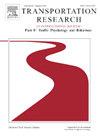Improving driving automation training through scaffolding of roles and responsibilities Information: A comparison between older and younger drivers
IF 3.5
2区 工程技术
Q1 PSYCHOLOGY, APPLIED
Transportation Research Part F-Traffic Psychology and Behaviour
Pub Date : 2025-02-01
DOI:10.1016/j.trf.2025.01.042
引用次数: 0
Abstract
Adaptive Cruise Control (ACC) is an Advanced Driver Assistance System (ADAS) commonly found in new vehicles that shares the responsibilities of maintaining headway and speed. However, drivers often have a limited understanding of their roles and responsibilities and how they should modify their behaviors when driving with ACC. This study investigates the effect of scaffolding teaching technique by providing additional background knowledge about ACC and highlighting drivers’ new roles and responsibilities for both older and younger adults during text-based ACC training programs. The study also initiates a new approach to evaluate drivers’ learning outcomes at different stages of driving automation training (i.e., reading behavior during training, post-training knowledge test, gaze monitoring behavior, and driving performance during simulated driving). Thirty-nine participants (20 younger + 19 older) received one of the two ACC training protocols: basic (system functionality, operational procedures, and limitations) and comprehensive (basic training + ACC background information and driving roles and responsibilities). The results showed that the comprehensive training led to reduced reading page revisits and adjusted workload during training, better performance in post-training knowledge tests, and more ACC engagement during simulated driving. The findings also suggested the feasibilities and connections within the new training evaluation approach that can provide insights into understanding ACC training outcomes through different stages. Future research is needed to further explore the effect of scaffolding teaching method on trainees’ learning-behavioral translation and the application of the new training evaluation approach to support experimental design or other in-vehicle technologies.
求助全文
约1分钟内获得全文
求助全文
来源期刊
CiteScore
7.60
自引率
14.60%
发文量
239
审稿时长
71 days
期刊介绍:
Transportation Research Part F: Traffic Psychology and Behaviour focuses on the behavioural and psychological aspects of traffic and transport. The aim of the journal is to enhance theory development, improve the quality of empirical studies and to stimulate the application of research findings in practice. TRF provides a focus and a means of communication for the considerable amount of research activities that are now being carried out in this field. The journal provides a forum for transportation researchers, psychologists, ergonomists, engineers and policy-makers with an interest in traffic and transport psychology.

 求助内容:
求助内容: 应助结果提醒方式:
应助结果提醒方式:


